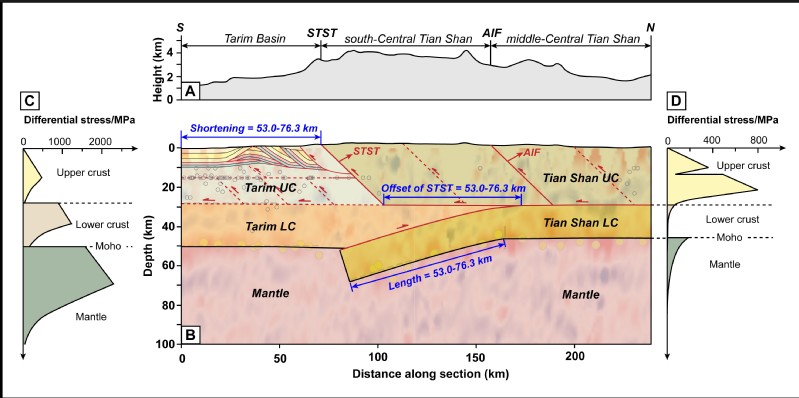Editor: 谢佳 Author: Time: 2023-10-23 Number of visits :136
Conventional plate tectonics theory views orogenesis as the product of the convergence of rigid plates, and orogenic settings are thus largely confined to plate boundaries and their immediate vicinity. However, widespread intracontinental tectonic activities, i.e., the wide basin and orogen system north far away from the India-Eurasia collision front, i.e., West Kunlun-Tarim-Tian Shan-Junggar transect, have challenged the traditional view. The geodetic datasets indicate that these intracontinental structures have accommodated a significant portion of the convergence. The mechanism by which the convergence has been accommodated has long been an issue that attracts worldwide attentions. The Tian Shan orogen in central Asia (Figure 1), one of the largest and most active intracontinental orogenic belts in the world, provides an excellent example to address this issue. Despite that the Tian Shan plays a key role in accommodating the intracontinental convergence driven by the India-Eurasia collision, the mechanism remains debatable. At least two competing models have been proposed, including (1) pure-shear shortening of the Tian Shan Orogen and the Tarim Basin possibly followed by delamination of the thickened Tian Shan lithosphere, and (2) underthrusting/subduction of the Tarim lithosphere beneath the Tian Shan. Quantifying the upper crustal deformation architecture and its shortening is vital to test these competing models.

Figure 1. Tectonic background of the study area. (A) Tectonic domains of Tibetan Plateau and its adjacent areas, with the study area shown in the dotted box. (B) Tectonic divisions of the Central Tian Shan and the adjacent Kepingtage FTB along northern Tarim Basin. (C) Geological cross section (line A-A`) of the Western Kepingtage FTB. FTB: fold-and-thrust belt; MCTS: the middle-Central Tian Shan; MPT: Main Pamir Thrust; NCTS: the north-Central Tian Shan; SCTS: the south-Central Tian Shan. (after Huang JL et al., 2023)
The basin structure research team of the Zhejiang University estimates the magnitude of Cenozoic shortening across the Western Kepingtage fold-and-thrust belt (FTB) which lies at the Tarim-Central Tian Shan convergent zone. Based on structural analyses of four high-resolution seismic reflection profiles that capture the upper crust structures of this region, we have published an article on the international journal of Geological Society of America Bulletin (Huang JL et al., 2023). The results suggest that the Western Kepingtage FTB displays a thin-skinned style of deformation at upper crust, with minimum north-south shortening estimates of ~76.70 km (~46.6% strain), ~93.2 km (~51.4% strain), ~67.1 km (~56.1% strain) and ~53.0 km (~49.9% strain), respectively from east to west. Assuming coupling shortening in the whole crustal scale and a pre-Cenozoic crustal thickness of ~41-46 km, these shortening ratios will predict a ~83-95-km-thick crust along the northern Tarim Basin, which is significantly larger than the present crustal thickness (50-60 km) as previously reported. This inconsistency leads us to rule out the pure-shear thickening model, which predicts crustal-scale coupling deformation. Alternatively, our results imply the crust of the northern Tarim Basin has been deformed in a decoupling style. These results, combined with previous studies, lend support to the intracontinental underthrusting model (Figure 2). We suggest that the upper crustal FTBs and the lower crustal underthrusting both function in accommodating the intracontinental convergence. Shortening and thickening of the weak Tian Shan lithosphere during early Cenozoic possibly produced an eclogitized lower lithosphere that delaminated at late Cenozoic to facilitate the underthrusting of the Tarim lower plate and deformation of the fold-and-thrust belts of the Tarim upper crust.

Figure 2. Cartoon showing convergent mode between the Central Tian Shan and the Tarim Basin. (after Huang JL et al., 2023)
The first author of this paper, Huang Jia-Lun, is a doctoral student at the School of Earth Sciences, Zhejiang University. Professor Chen Han-Lin of Zhejiang University are the corresponding authors. This research was supported by the Second Tibetan Plateau Scientific Expedition and Research of China (grant no. 2019QZKK0708), the National Natural Science Foundation of China (grant nos. U22B6002, 41720104003, 41972217, and 42002219), and the Fundamental Research Funds for the Zhejiang Provincial Universities of China (grant nos. 2021XZZX005,2019FZA3008, and 2019QNA3013).
Article information: Huang, J., Chen, H., Lin, X., An, K., Cheng, X., Li, Y., Yang, X., Zhang, L., Chen, C., 2023a. Intracontinental convergence accommodated by underthrusting of Tarim Basin beneath central Tian Shan, Central Asia: Insights from Cenozoic upper crust deformation across the western Kepingtage fold-and-thrust belt in the northern Tarim Basin. GSA Bull. https://doi.org/10.1130/B36927.1.
